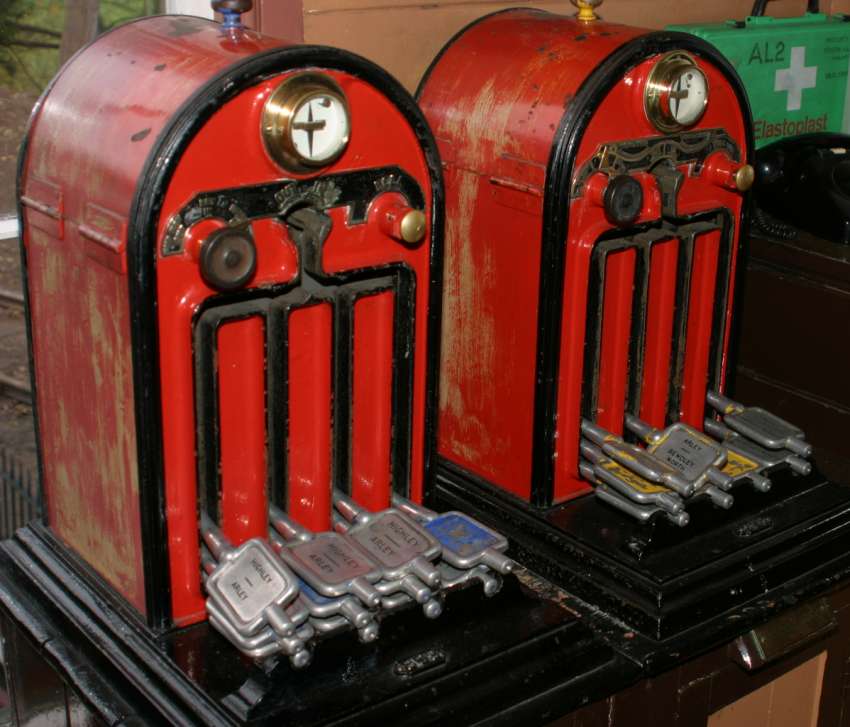ETT
Electric Train Token (ETT) is a system of controlling traffic over a single line.
Its most easily understood form is that where a token instrument is installed in the signal box at each end of the single line section thus forming an electrically connected pair. Each instrument has an electro-mechanical arrangement such that only one token can be removed from one of a pair of instruments with the cooperation of the signalman at the other end of the single line section. No other token can be removed until the originally removed token is replaced in one of the two instruments.
A token gives the driver of a train authority to occupy the single line section. Only in very exceptional circumstances may another train enter the section without being in possession of a token, or two trains be present in the same section.
The SVR uses Tyer's Key Token instruments. 
Much like a key for a mortice lock the end of the token that is placed into the instrument is made with four different "wards" to prevent a key being placed into the wrong instrument where multiple instruments are housed in one signal box. E.g Highley has an example of all four Tyer's Key Token instruments. Long sections to Bridgnorth and Bewdley North plus short sections to Hampton Loade and Arley. As an additional measure to deter a signalman trying to insert a token into the wrong instrument the differing tokens are colour coded either Red, Yellow, Blue or Green. This is colour is also carried on the knob on the top of the instrument
Basic Method of Operation
Signalman A wishing to send a train will send the "Call Attention" bell signal. When signalman B at the other end of the section acknowledges the "Call Attention" bell signal, signalman A will send "Is the line clear for (the particular type of train)" n.b. there are different bell signals for different train types. If signalman B accepts the train, they will respond by repeating the bell code but keep the bell plunger held in on the final beat of the signal. Keeping the plunger held in releases the mechanism of signalman A's token instrument, if no other token is presently withdrawn from either instrument, so the signalman can remove a token. When signalman A withdraws the token from the instrument both signalmen will set their indicators to show that a token is out, and in which direction the train is travelling.
Removing the token will unlock the section signal which allows trains to enter the single line between the two signal-boxes. Signalman A will clear this signal, put the token into a token carrier, and give it to the footplate crew. The token recipient will read out loud the signal box names as a further means of checking they have the correct token for the single line section they are to pass over. As the train departs, signalman A will check it is showing the correct tail lamp at the end of the train, and send "Train Entering Section" to signalman B.
When the train arrives at the far end of the section the crew will hand the token, in its carrier, to signalman B. When signalman B has seen the tail lamp on the back of the train or the guard has confirmed the train has arrived complete, signalman B will place the token in their instrument, put their indicator to normal, and send "Train Out Of Section" to signalman A.
Signalman A will then return the indicator to normal. Both signalmen will indelibly record each of the above events along with the time as they occur in the Train Register.
Additional Features
Where intermediate an siding exists where a train may be locked in, it is possible to provide an intermediate instrument into which the token may be placed once the train is clear of the running line and the points are set appropriately.
When the token has been placed into the intermediate instrument signalmen at either end may withdraw a token from their local instrument to allow another train to run between the two signal boxes in the manner described previously.
This method of working is available for use when Arley is switched out. The long (Bewdley to Highley) section token may be used in an intermediate instrument using the signal-box as a ground frame.